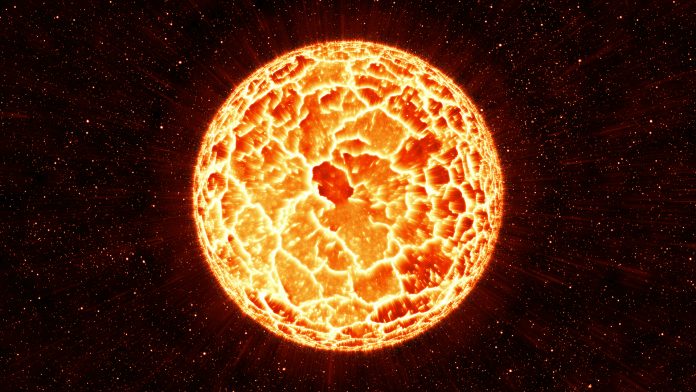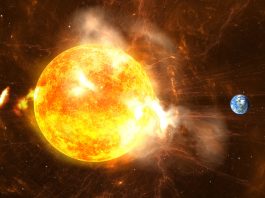Scientists were able to create a liquid metal experiment to uncover the mystery regarding the high temperatures reached by the Sun’s corona.
The Sun’s corona
At 15 million degrees Celsius, the centre of our Sun is unimaginably hot. At its surface, it emits its light at a comparatively moderate 6000 degrees Celsius; this is a phenomenon that has perplexed scientists for years. Many have attempted to explain this with experiments developed without the use of liquid metal, including a team from the Helmholtz-Zentrum Dresden-Rossendorf (HZDR) German national lab.
Rather than use liquid metal, the German team developed an experiment using the molten alkali metal rubidium and pulsed high magnetic fields. In doing so they became the first to develop a laboratory model that empirically proved the theoretically predicted behaviour of the plasma waves (or Alfvén waves) said to be found in the Sun’s corona.
“Just below the Sun’s corona lies the so-called magnetic canopy, a layer in which magnetic fields are aligned largely parallel to the solar surface,” explained Dr Frank Stefani, lead scientist on this study. “Here, sound and Alfvén waves have roughly the same speed and can therefore easily morph into each other. We wanted to get to exactly this magic point – where the shock-like transformation of the magnetic energy of the plasma into heat begins.”
Magnetic fields play a dominant role in heating the Sun’s corona; however, it remains controversial whether this effect is mainly due to a sudden change in magnetic field structures in the solar plasma or to the dampening of different types of waves. New research from the Dresden team focuses on the so-called Alfvén waves that occur below the corona in the hot plasma of the solar atmosphere, which is permeated by magnetic fields.
The magnetic fields acting on the ionized particles of the plasma resemble a guitar string, whose playing triggers a wave motion. Just as the pitch of a strummed string increases with its tension, the frequency and propagation speed of the Alfvén wave increases with the strength of the magnetic field.
Using liquid metal
Alfvén waves have been detected by scientists in liquid metal experiments as early as 1942 and studied in elaborate plasma physics facilities. Large plasma experiments revealed that the Alfvén speed is typically much higher than the speed of sound. However, in all liquid-metal experiments to date, it has been significantly lower. From this, scientists discovered the relatively low magnetic field strength of common superconducting coils which had a constant field of about 20 tesla (T).
The HZDR team, using the Dresden High Magnetic Field Laboratory (HLD), were able to replicate pulsed magnetic fields with maximum values of almost 100T, which corresponds to about two million times the strength of the Earth’s magnetic field. Scientists observed liquid metal properties to discover whether these extremely high fields would allow Alfvén waves to break through the sound barrier.
When designing the experiment, scientists worried about using liquid metal as rubidium ignites spontaneously in air and reacts violently with water. Dr Thomas Herrmannsdörfer from the HLD dispelled these concerns and explained, “Our energy supply system for operating the pulse magnets converts 50 megajoules in a fraction of a second – with that, we could theoretically get a commercial airliner to take off in a fraction of a second. When I explained to my colleagues that a thousandth of this amount of chemical energy of the liquid rubidium does not worry me very much, their facial expressions visibly brightened.”
However, despite these assurances, scientists struggled to achieve success from this experiment. Using liquid metal meant that pressures had to be used that were up to fifty times the atmospheric pressure generated in the pulsed magnetic field. To achieve this safely, the rubidium melt had to be enclosed in a sturdy stainless-steel container, which an experienced chemist must fill.
By injecting an alternating current at the bottom of the container while simultaneously exposing it to the magnetic field, it was finally possible to generate Alfvén waves in the melt, whose upward motion was measured at the expected speed.
Findings
Using liquid metal and the magic field strength of 54T, all measurements were dominated by the frequency of the alternating current signal, and at this point exactly a new signal with halved frequency was detected. This sudden period doubling was in perfect agreement with the theoretical predictions.
This liquid metal experiment revealed that the Alfvén waves of Stefani’s team had broken through the sound barrier for the first time. Although not all observed effects can yet be explained so easily, the work contributes an important detail to solving the puzzle of the Sun’s corona heating. For the future, the researchers are planning detailed numerical analyses and further experiments.
Research on the heating mechanism of the Sun’s corona is also being carried out elsewhere: the Parker Solar Probe and Solar Orbiter space probes are about to gain new insights at close range.









